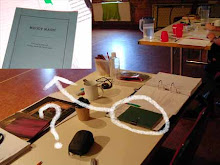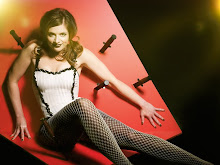
Vaudeville Rehearsal Day 21. (Tuesday)
Yesterday the actors had the day off. With the performance schedule beginning this week the actors will be working nights, so Monday was a rest day. That doesn't mean that no work is happening on the show. The time away from the rehearsal room gives the rest of the team time to concentrate on the technical elements.
Tuesday begins with a run of the show in the morning and then another run of the second and third acts in the afternoon. Both of these rehearsals take place in the rehearsal room; I was a little premature in calling the end of the rehearsals in the Bagging Room in the most recent post.
There's going to be a lighting plot tonight and tomorrow morning. Chris tells the cast before the afternoon session that it's going to be predominately tech time after this, so they really need to hit their performances today.
As has already been mentioned, there is a lot of technical detail in this show, so we're going to need all of the tech time available to get the technical scenes into shape.
Creating a lighting design is an interesting process for anybody who's never seen it done. The lighting designer in collaboration with the director creates a lighting plan and supervises the rigging and the focussing of the lights. (The 'rig' is where the lights are hung. The 'focus' is where the light is pointed, and the quality of the light as it can be manipulated within the lantern.)
Then there is the 'plot.' In the 'plot' the lighting designer brings up each lighting 'state' that has been designed for each scene and transition. Then the director asks for lights to be higher or lower, or lights to be added or subtracted from the state. 'Walkers' mimic the movement of the actors on stage so everybody can tell what the scene will look like.
A good relationship between the lighting designer and the director is really important through this process. In many ways it's pain-staking, detailed work. A common conversation sounds like this;
Lighting Designer - “Scene 12. Lamp number 20 at 50%, 21 at 60%, 33 at 45%, 40 at 50...”
(He says this to the lighting board operator who drives the board)
Director - “Can we have the downstage area a bit brighter?”
Lighting Designer - “Okay. Let's change 20 to 60% and 21 to 60%.”
Director - “Can we remove that shadow on the edge of that wall”
Lighting - “Yeah, can you bring up 43 to 20 and drop 21 to 35.”
This basic conversation gets repeated in a variety of ways as they massage the states into shape. On large shows cues and states can run into hundreds. (I'm not sure how many cues Richard has plotted for Vaudeville.) And there's not a great deal of time to 'test' anything. If a state feels wrong or doesn't light the area that the actors play the scene in, the time in which to change things is limited. It's not negligible, but it's limited. And with big changes that require extra lamps to be rigged and focused, sometimes a choice has to be made about which changes of this are most important because there might not be time for them all.
Chris has worked with most of the design and technical team numerous times before, and it really shows when they're doing the plot. The communication is clear, the mood is relaxed and the they move through things with a great deal of efficiency. More important than that, the atmosphere and dialogue is more creative than it is functional.
Although there's a clear order of states that the team work through, and a lot of “Lamp 20 at 60, 30 at 40” etc, the work they do in this time is not nearly as linear as it sounds. There are lots of minor changes and tweaks across many elements of the show; the set, the physical patterns, the action of the actors, the props, as well as the lights themselves. This is all happening simultaneously at the same time as they work through each of the lighting states. Ideas come across many different aspects of the show that are 'banked' to keep working on if they have the time.
It's a tremendously exciting time. As lights are brought up for each state in the show, the stage begins to live and everybody gets their first glimpses of what the show is going to look like once it hits the stage. It's absolutely tremendous. The Beckett is looking incredible.
Tuesday begins with a run of the show in the morning and then another run of the second and third acts in the afternoon. Both of these rehearsals take place in the rehearsal room; I was a little premature in calling the end of the rehearsals in the Bagging Room in the most recent post.
There's going to be a lighting plot tonight and tomorrow morning. Chris tells the cast before the afternoon session that it's going to be predominately tech time after this, so they really need to hit their performances today.
As has already been mentioned, there is a lot of technical detail in this show, so we're going to need all of the tech time available to get the technical scenes into shape.
Creating a lighting design is an interesting process for anybody who's never seen it done. The lighting designer in collaboration with the director creates a lighting plan and supervises the rigging and the focussing of the lights. (The 'rig' is where the lights are hung. The 'focus' is where the light is pointed, and the quality of the light as it can be manipulated within the lantern.)
Then there is the 'plot.' In the 'plot' the lighting designer brings up each lighting 'state' that has been designed for each scene and transition. Then the director asks for lights to be higher or lower, or lights to be added or subtracted from the state. 'Walkers' mimic the movement of the actors on stage so everybody can tell what the scene will look like.
A good relationship between the lighting designer and the director is really important through this process. In many ways it's pain-staking, detailed work. A common conversation sounds like this;
Lighting Designer - “Scene 12. Lamp number 20 at 50%, 21 at 60%, 33 at 45%, 40 at 50...”
(He says this to the lighting board operator who drives the board)
Director - “Can we have the downstage area a bit brighter?”
Lighting Designer - “Okay. Let's change 20 to 60% and 21 to 60%.”
Director - “Can we remove that shadow on the edge of that wall”
Lighting - “Yeah, can you bring up 43 to 20 and drop 21 to 35.”
This basic conversation gets repeated in a variety of ways as they massage the states into shape. On large shows cues and states can run into hundreds. (I'm not sure how many cues Richard has plotted for Vaudeville.) And there's not a great deal of time to 'test' anything. If a state feels wrong or doesn't light the area that the actors play the scene in, the time in which to change things is limited. It's not negligible, but it's limited. And with big changes that require extra lamps to be rigged and focused, sometimes a choice has to be made about which changes of this are most important because there might not be time for them all.
Chris has worked with most of the design and technical team numerous times before, and it really shows when they're doing the plot. The communication is clear, the mood is relaxed and the they move through things with a great deal of efficiency. More important than that, the atmosphere and dialogue is more creative than it is functional.
Although there's a clear order of states that the team work through, and a lot of “Lamp 20 at 60, 30 at 40” etc, the work they do in this time is not nearly as linear as it sounds. There are lots of minor changes and tweaks across many elements of the show; the set, the physical patterns, the action of the actors, the props, as well as the lights themselves. This is all happening simultaneously at the same time as they work through each of the lighting states. Ideas come across many different aspects of the show that are 'banked' to keep working on if they have the time.
It's a tremendously exciting time. As lights are brought up for each state in the show, the stage begins to live and everybody gets their first glimpses of what the show is going to look like once it hits the stage. It's absolutely tremendous. The Beckett is looking incredible.




Sounds like a very intense process. Can't wait to see the finished result!
ReplyDeleteThe count-down to opening on the site is to the preview performance, isn't it? So there's a bit more time between that and the actual Opening Night, right?
ReplyDeleteIs the show likely to change much at the last minute, after a few "test runs" with audiences at the previews?
Good question. I'll ask Chris for you!!
ReplyDeletePlotting lights sounds really boring actually! Can't wait to see the show this weekend. But also curious to know whether there's usually much difference between previews and opening night?
ReplyDeleteAnd - who exactly is writing this blog?
Hi nicce reading your blog
ReplyDelete